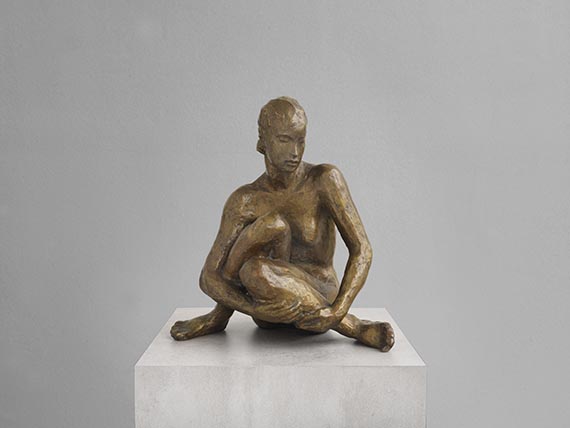Back side
2
Georg Kolbe
Sitzende, 1926.
Bronze with golden-brown patina
Estimate:
€ 50,000 / $ 59,000 Sold:
€ 139,700 / $ 164,846 (incl. surcharge)
Sitzende. 1926.
Bronze with golden-brown patina.
Berger 91. Stand with the monogram in ligature and the foundry mark "H. Noack Berlin Friedenau". One of 66 lifetime casts. 28 x 25 x 18 cm (11 x 9.8 x 7 in).
• Cast during the artist's lifetime.
• The "Sitzende" was made at the peak of Kolbe's creativity.
• One of the artist's most popular sculptures even during his lifetime.
• Fascinating contrast of introspection and graceful presence.
Accompanied by a certificate of authenticity issued by Dr. Ursel Berger, Berlin, on May 1, 2023.
PROVENANCE: In possesion of a German family for several generations.
EXHIBITION: Other copies can be found in the following museums:
Karl Ernst Osthaus Museum, Hagen.
Magdeburg Municipal Collections.
LITERATURE: Each a different copy:
Richard Scheibe und Georg Kolbe. Georg Kolbe 100 Lichtdrucktafeln, Marburg 1931, plates 54 and 55 a, b.
Rudolf G. Binding, Vom Leben der Plastik. Inhalt und Schönheit des Werkes von Georg Kolbe, Berlin, no date (around 1936), p. 40 with illu.
Bronze with golden-brown patina.
Berger 91. Stand with the monogram in ligature and the foundry mark "H. Noack Berlin Friedenau". One of 66 lifetime casts. 28 x 25 x 18 cm (11 x 9.8 x 7 in).
• Cast during the artist's lifetime.
• The "Sitzende" was made at the peak of Kolbe's creativity.
• One of the artist's most popular sculptures even during his lifetime.
• Fascinating contrast of introspection and graceful presence.
Accompanied by a certificate of authenticity issued by Dr. Ursel Berger, Berlin, on May 1, 2023.
PROVENANCE: In possesion of a German family for several generations.
EXHIBITION: Other copies can be found in the following museums:
Karl Ernst Osthaus Museum, Hagen.
Magdeburg Municipal Collections.
LITERATURE: Each a different copy:
Richard Scheibe und Georg Kolbe. Georg Kolbe 100 Lichtdrucktafeln, Marburg 1931, plates 54 and 55 a, b.
Rudolf G. Binding, Vom Leben der Plastik. Inhalt und Schönheit des Werkes von Georg Kolbe, Berlin, no date (around 1936), p. 40 with illu.
Georg Kolbe reached the peak of his creativity in the mid-1920s. In the autumn of 1921, Paul Cassirer dedicated a solo exhibition to Kolbe and the first monograph on Kolbe's work, written by Wilhelm Reinhold Valentiner, was published a year later. Kolbe's idealized nude sculptures established his rank as one of the most important sculptors of the early 20th century. From the early 1920s on, Kolbe created various motifs of the seated nude, including the present bronze. At the same time, Georg Kolbe developed a great interest in expressionist painting. He acquired works by Kirchner and Pechstein and was a lifelong friend of Schmidt-Rottluff. He was also fascinated by the newly discovered non-European art and the rediscovered forms of medieval art. The occupation with these artistic impulses encouraged the artist to continue pursuing the path he had taken. By deviating from the natural model, he created figures that, with their stylized outlines and sharp ridges, abandon the delicate forms of earlier works in favor of an energetic, powerful charisma. Hanna Weber was Kolbe’s model for this small sculpture, which the artist recorded with the title "Sitzende H.W." in his notes. The extraordinary fact that Kolbe noted down the initials of his models helps research a great deal in identifying them. The young woman sat for several figures around 1925/26, as she seemed to have had an ability to move in a particularly natural and unconstrained manner that inspired him to very special works. Today’s research has identified the sitter as Hanna Weber, an art student, who later emigrated to the USA with her husband, where she worked as an artist. She stands for the sporty, somewhat androgynous type of woman that was particularly admired in the 1920s. The girlish tenderness of the earlier sculptures gave way to depictions of women characterized by a calm sovereignty. The sculptures for which Hanna Weber posed all possess a certain expressive appeal, as Kolbe put focus on unusual poses. In the present "Sitzende" from 1926, the posture of the legs and arms is particularly striking. The extremely interlocked legs enclosed by the arms, convey a strong defensive stance. Despite her introspection, her appearance is present and graceful. These calm but expressive sculptures are highly sought-after and were among the most popular sculptures even during his lifetime. [SM]
2
Georg Kolbe
Sitzende, 1926.
Bronze with golden-brown patina
Estimate:
€ 50,000 / $ 59,000 Sold:
€ 139,700 / $ 164,846 (incl. surcharge)
Headquarters
Joseph-Wild-Str. 18
81829 Munich
Phone: +49 89 55 244-0
Fax: +49 89 55 244-177
info@kettererkunst.de
Louisa von Saucken / Undine Schleifer
Holstenwall 5
20355 Hamburg
Phone: +49 40 37 49 61-0
Fax: +49 40 37 49 61-66
infohamburg@kettererkunst.de
Dr. Simone Wiechers / Nane Schlage
Fasanenstr. 70
10719 Berlin
Phone: +49 30 88 67 53-63
Fax: +49 30 88 67 56-43
infoberlin@kettererkunst.de
Cordula Lichtenberg
Gertrudenstraße 24-28
50667 Cologne
Phone: +49 221 510 908-15
infokoeln@kettererkunst.de
Hessen
Rhineland-Palatinate
Miriam Heß
Phone: +49 62 21 58 80-038
Fax: +49 62 21 58 80-595
infoheidelberg@kettererkunst.de
We will inform you in time.




 Lot 2
Lot 2 
